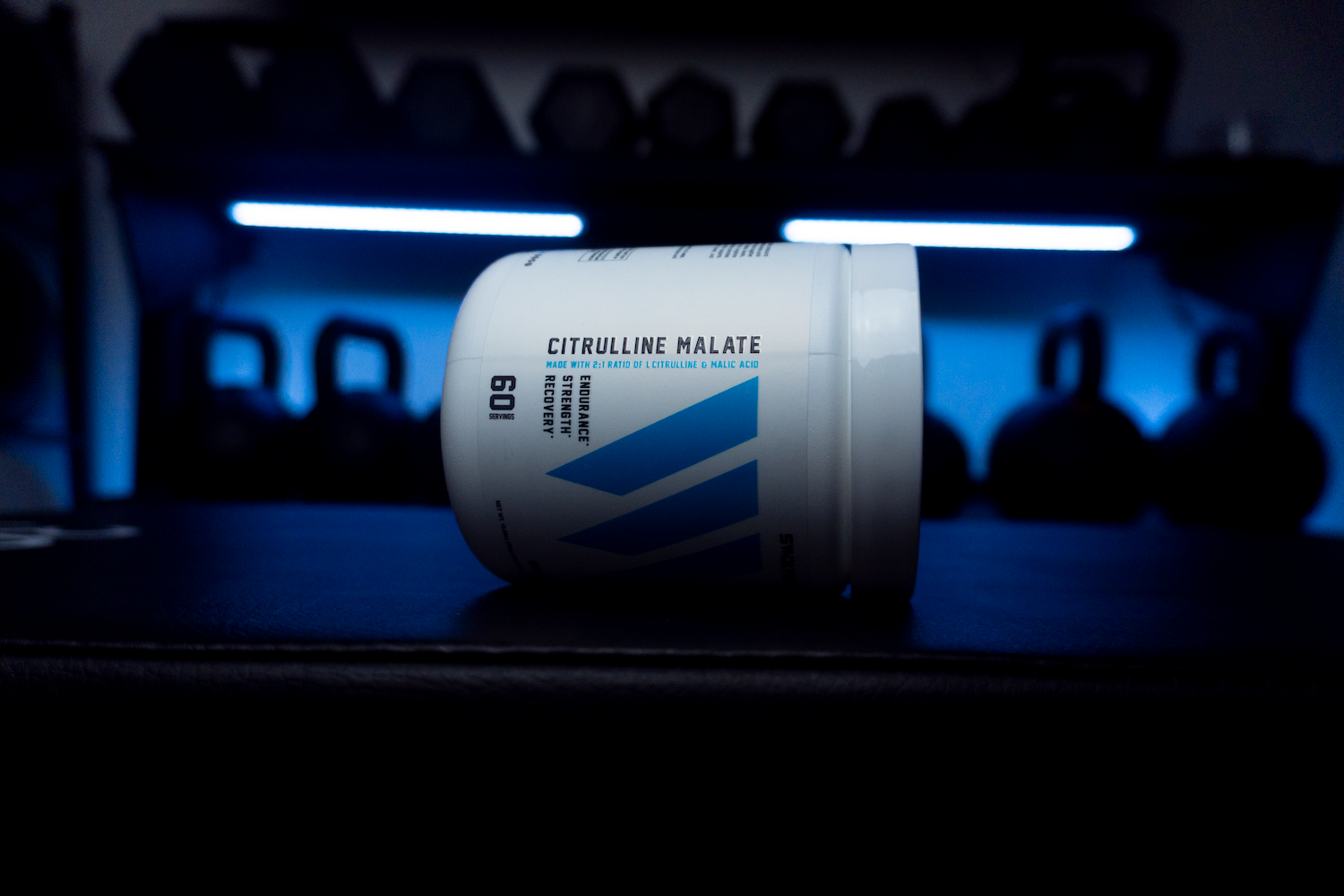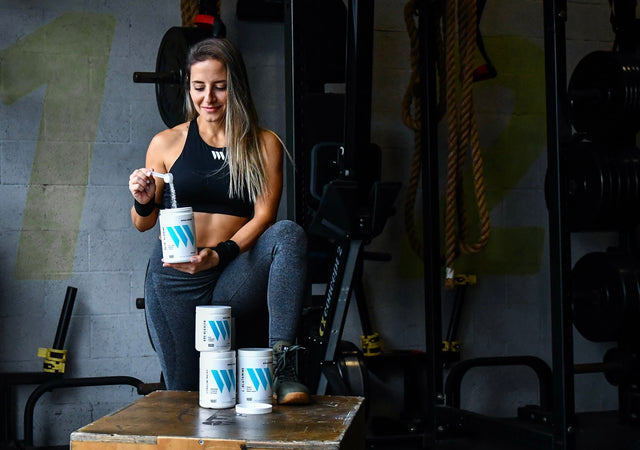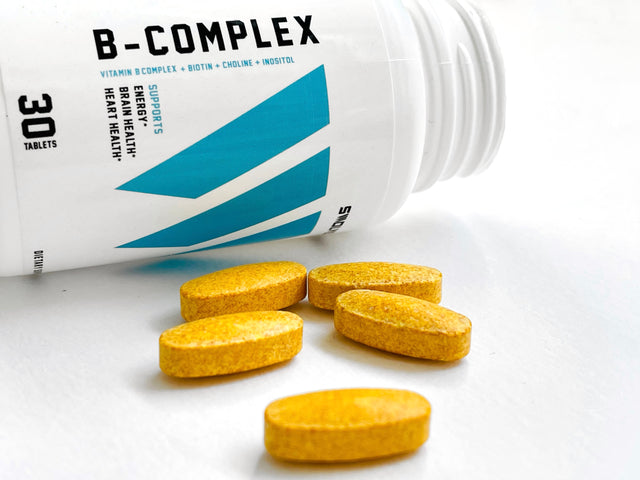As an active individual and consistent workerouter, you’re constantly on the hunt for more ways to improve athletic performance, increase strength, and recover faster. One of the best ways to improve your performance is through supplementing with Citrulline Malate. Due to the many proposed benefits, it has on protein synthesis, amino acid utilization, nitric oxide production, and the delay of muscle fatigue through enhancements of aerobic and anaerobic production, Citrulline Malate is one of the best ingredients you can include in your pre-workout regimen. We’re going to discuss the health benefits of Citrulline Malate and exactly how it can improve your athletic performance.
What Is Citrulline Malate?
Citrulline Malate is a compound formed by combining L-Citrulline, a non-essential amino acid, with malate (malic acid), an intermediate of the Krebs (TCA) cycle. Originally used in Europe to treat fatigue, muscle weakness, and even dementia, Citrulline Malate has transitioned into sports performance supplements due to its documented effects on energy production, endurance, and muscle recovery.
A 2002 study published in Fundamental & Clinical Pharmacology found that 15 days of Citrulline Malate supplementation significantly improved aerobic energy production and reduced the sensation of fatigue in patients with asthenia (Bendahan et al., 2002).
Despite its inclusion in many pre-workouts, most formulas under-dose Citrulline Malate, typically providing only 1–3 grams per serving. However, research supports a clinically effective dose of 5–8 grams per serving for optimal performance benefits (Wax et al., 2015).
How Does Citrulline Malate Work?
Citrulline Malate enhances performance through several mechanisms:
-
L-Citrulline enters the urea cycle, helping detoxify ammonia, a metabolic waste product from protein breakdown during exercise.
-
In the liver, Citrulline is converted into arginine, increasing plasma arginine levels and promoting nitric oxide (NO) production.
-
Nitric oxide acts as a vasodilator, increasing blood flow, oxygen delivery, and nutrient transport to working muscles.
According to a study in Journal of the International Society of Sports Nutrition, Citrulline Malate improves oxygen utilization and delays fatigue through NO-mediated vasodilation and enhanced ATP production (Sureda et al., 2010).
Citrulline Malate vs. L-Arginine
Although both Citrulline Malate and Arginine increase nitric oxide levels, Citrulline Malate is more effective. Arginine undergoes first-pass metabolism (FPM) in the gastrointestinal tract and liver, reducing its bioavailability.
In contrast, Citrulline bypasses FPM and results in greater plasma arginine levels than supplementing with arginine itself (Schwedhelm et al., 2008, British Journal of Clinical Pharmacology).
Citrulline Malate vs. L-Citrulline
L-Citrulline is the free-form amino acid found in some supplements, but Citrulline Malate is more effective for performance enhancement. While L-Citrulline supports NO production, it lacks the malate component, which contributes to ATP production via the TCA cycle.
Malate supports aerobic energy production and delays fatigue through anaplerotic reactions, enhancing endurance capacity (Callis et al., 1991, Journal of Sports Medicine and Physical Fitness).
5 Clinically Proven Benefits of Citrulline Malate
1. Increases Aerobic Energy and Delays Fatigue
In a double-blind study, 18 men with physical fatigue were administered 6g/day of Citrulline Malate for 15 days. Results showed a 34% increase in oxidative ATP production and a 20% increase in phosphocreatine recovery, confirming improved aerobic performance and reduced fatigue.
(Bendahan et al., 2002, Fundamental & Clinical Pharmacology)
2. Reduces Muscle Soreness and Enhances Recovery
A randomized controlled trial involving 41 resistance-trained men found that 8g of Citrulline Malate significantly increased reps to failure by 52.9% and reduced post-exercise muscle soreness by 40% at 24 and 48 hours post-training.
(Pérez-Guisado & Jakeman, 2010, Journal of Strength and Conditioning Research)
3. Boosts Nitric Oxide Production
Citrulline Malate elevates plasma arginine levels, leading to enhanced nitric oxide synthesis. This results in vasodilation, which improves circulation and oxygen delivery during training without increasing blood pressure.
(Bailey et al., 2015, European Journal of Applied Physiology)
4. Facilitates Protein Synthesis
Higher plasma arginine stimulates the mTOR pathway, which supports muscle protein synthesis. This helps with muscle repair, hypertrophy, and strength maintenance, especially important during high-volume or CrossFit-style training.
5. Enhances Amino Acid Utilization During Endurance Training
In a study on 17 elite cyclists, 6g of Citrulline Malate improved amino acid retention, increased plasma growth hormone, and elevated citrulline, arginine, ornithine, and nitrite levels post-exercise—enhancing endurance and recovery.
(Sureda et al., 2010, Journal of the International Society of Sports Nutrition)
RELATED ARTICLE: 3 Clinically Proven Benefits of Citrulline Malate
RELATED ARTICLE: Citrulline Malate: The Best Supplement for CrossFit
Citrulline Malate FAQs
What is Citrulline Malate?
Citrulline Malate is a compound made by combining L-Citrulline, an amino acid, with malate, a salt of malic acid involved in the body’s energy production (Krebs cycle). It’s commonly used in pre-workout supplements to support endurance, reduce fatigue, and increase nitric oxide (NO) production.
What does Citrulline Malate do?
Citrulline Malate increases plasma arginine levels, which enhances nitric oxide production. Nitric oxide acts as a vasodilator, improving blood flow, oxygen delivery, and nutrient transport to working muscles. It also supports aerobic energy production, reduces muscle soreness, and enhances recovery.
What is the difference between Citrulline Malate and L-Citrulline?
While both forms increase nitric oxide production, Citrulline Malate includes malate, which enhances aerobic ATP production by participating in the TCA (Krebs) cycle. This means Citrulline Malate supports both circulation and energy output, making it superior for improving performance and endurance compared to L-Citrulline alone.
What’s the difference between Citrulline Malate and Arginine?
Arginine is a direct precursor to nitric oxide, but it undergoes first-pass metabolism in the liver and GI tract, which limits its effectiveness. Citrulline Malate bypasses this process, resulting in higher plasma arginine levels and more efficient nitric oxide production.
How much Citrulline Malate should I take?
The clinically effective dose ranges from 6 to 8 grams taken 30–60 minutes before exercise. Many pre-workouts underdose Citrulline Malate, often including only 2–4g, which is below the amount proven in studies to improve performance.
Reference: Pérez-Guisado & Jakeman, 2010 – J Strength Cond Res
Can I take Citrulline Malate every day?
Yes. Daily use of Citrulline Malate is considered safe and well-tolerated, even in doses up to 10g per day. Regular use may provide cumulative benefits for endurance, recovery, and muscle oxygenation.
When should I take Citrulline Malate?
For performance benefits, take Citrulline Malate 30 to 60 minutes before your workout. It can also be combined with other pre-workout ingredients like creatine, beta-alanine, or caffeine.
Can I stack Citrulline Malate with other supplements?
Yes. Citrulline Malate stacks well with:
-
Creatine – for strength and power
-
Beta-Alanine – for muscular endurance
-
BCAAs/EAA – for muscle recovery
-
Caffeine – for energy and focus
This combination is commonly used in advanced pre-workout formulations.
Is Citrulline Malate safe?
Citrulline Malate has been shown to be safe and free from significant side effects in clinical studies, even at higher doses. Some users may experience mild stomach discomfort at doses above 10g, so starting at 6g is generally advised.
Reference: Sureda et al., 2010 – JISSN
Does Citrulline Malate improve muscle pumps?
Yes. By increasing nitric oxide, Citrulline Malate enhances blood flow and vascularity, resulting in stronger muscle pumps and better nutrient delivery during training.
Can Citrulline Malate help with muscle soreness?
Yes. Citrulline Malate has been shown to reduce delayed-onset muscle soreness (DOMS) up to 40% post-exercise by improving blood flow and clearing metabolic waste more efficiently.
Reference: Pérez-Guisado & Jakeman, 2010
Final Thoughts: Why Citrulline Malate Belongs in Your Supplement Stack
When it comes to enhancing performance, endurance, recovery, and nitric oxide production, Citrulline Malate stands out as one of the most effective and research-supported ingredients available. Backed by decades of clinical use and scientific validation, it delivers measurable improvements in aerobic energy production, muscle endurance, training volume, and post-workout recovery.
Unlike many trendy or underdosed pre-workout ingredients, Citrulline Malate works because it's built on real biochemistry—supporting the urea cycle, boosting plasma arginine levels, and fueling the TCA cycle to produce more ATP. And unlike L-Arginine or free-form Citrulline, it bypasses first-pass metabolism and delivers both pump and performance.
If you're serious about training, Citrulline Malate isn’t just a "nice to have"—it’s a strategic advantage. Whether you're chasing PRs in the gym, improving stamina for endurance sports, or just looking to recover faster and train harder, a clinically effective dose of 6–8g can be a game-changer.
Don’t settle for a formula that cuts corners. Look for products that deliver full clinical dosing, clean ingredient profiles, and transparency—because your results depend on it.
RELATED PRODUCT:
Swolverine Citrulline Malate – Full Clinical Dose, Research-Backed Formula
Find similar articles:
Cirtulline Citrulline Malate CrossFit L-Citrulline Nitric Oxide NO Booster Nutrition Supplements






